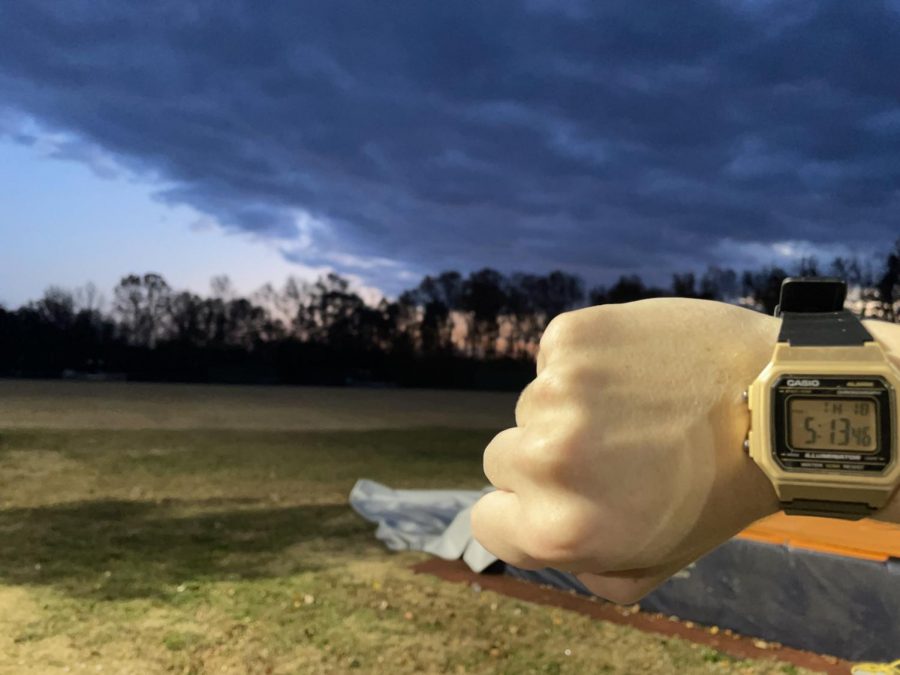‘Tis the season to be depressed
Photo courtesy of Robbie Kugler
The sun setting at just 5:13 p.m. One of the most common causes of winter-pattern seasonal affective disorder (SAD) is the shorter days, as that increasing lack of sunlight can have a very negative effect on a person’s health.
Spartans, isn’t it just the most wonderful time of the year? Well, for the millions of Americans who suffer from seasonal affective disorder (SAD), it’s probably not.
SAD, also referred to as seasonal depression, is a form of major depression specifically triggered by the change of seasons. For most people diagnosed with SAD, the shift from autumn to winter will trigger depressive episodes, but a smaller percentage of people have their symptoms triggered by the spring and summer months instead, which is known as summer-pattern SAD. In either case, the condition can have devastating effects on a person’s mental health, and many people without a diagnosis may still experience milder symptoms.
“I think the majority of people in general struggle more in winter than they do in summertime,” said clinical social worker Cynthia Crisafulli. “So even if you’re not diagnostically significant for seasonal affective disorder, you might experience a somewhat lower mood and higher stress.”
Clinically, SAD is diagnosed when a person shows clear major depressive symptoms during specific seasons for at least two consecutive years. Additionally, throughout the respective seasons, their depressive episodes must be more frequent than in other times of the year. As a result, many people who suffer from the disorder may not even know that they do, and even if they recognize their symptoms, they may shove them off as nothing more than “winter blues.” This is further compounded by a lack of dedicated attention for the disorder in the overall health curriculum.
“There’s probably not an entire lesson on [seasonal affective disorder],” said Health and P.E. department chair Jennifer Davies. “There [are] a lot of topics we have to cover in a very short amount of time, so it’s not its own exact lesson. A lot of things, in my opinion, probably don’t get a ton of individual attention [in the curriculum].”
Fortunately, when and if the pattern is recognized, SAD becomes inherently predictable. If someone knows ahead of time that they will probably feel worse around a certain time of year, they can take steps to alleviate their symptoms. Whether one experiences full-on depressive episodes, or more mild symptoms akin to the aforementioned “winter blues,” there are ways to make this upcoming winter more manageable.
“I would recommend the same things that I would recommend for [depression],” said Crisafulli. “Making sure you’re getting enough exercise, making sure that you’re getting adequate sleep. Making sure that you’re staying connected with people is really important when you’re experiencing depression. And then, specifically about the seasonal effect of stuff, getting as much natural light as you can. Being outside, even if it’s cold outside, is really good for [seasonal affective disorder]. Actually, the most common treatment for seasonal affective disorder is using light therapy.”
The end of daylight saving time has drastically reduced evening light, and the days are only getting shorter as winter draws closer. But global warming also made this autumn one of the warmest and sunniest in recent memory. Even though temperatures are dropping now, the first two months of the school year almost seemed like an extension to summer, as the transition to winter weather was far more drawn out than usual. Students have thus far been able to spend more time outside, and even the general aspect of being back in person this year is a huge help.
“I think that we’re all better off now being back in school,” said Crisafulli. “Last year, I can only imagine what the level of seasonal affective disorder was, [because] everybody was at home. The things that tend to stave off depression, like interacting with friends and doing activities that you enjoy, a lot of people weren’t able to do that stuff anymore. So my hope is now that we’re back to a somewhat more normal life, that won’t be so much the case this winter.”






